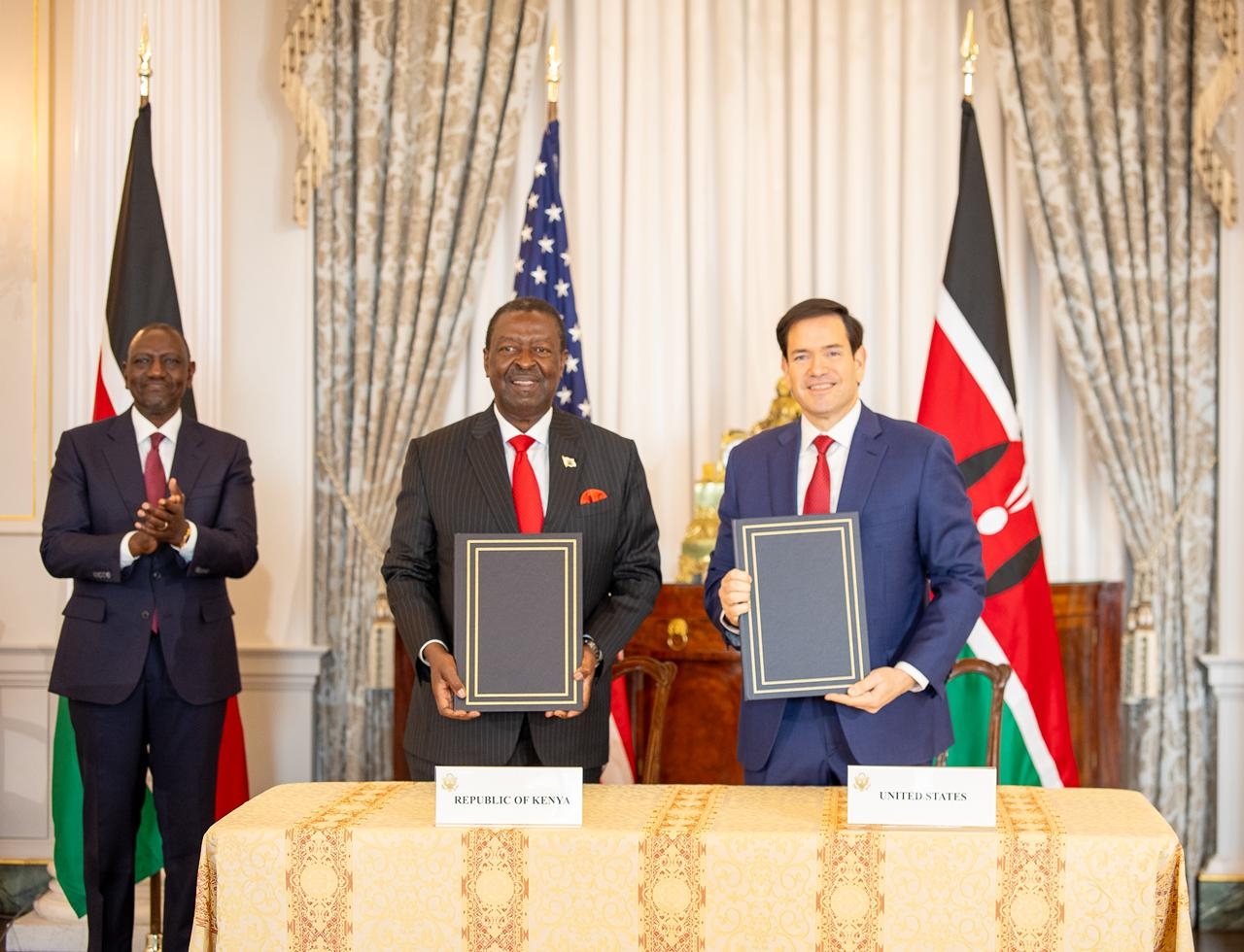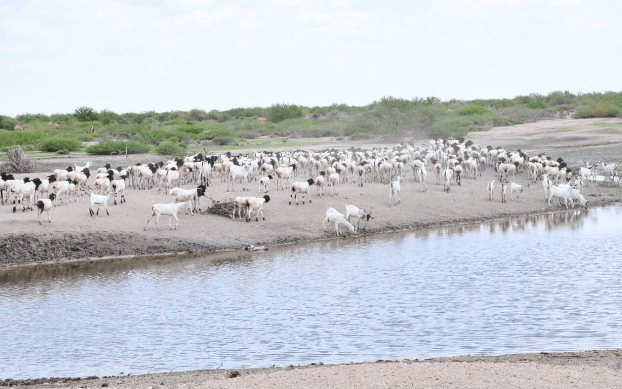The early morning chilly breeze sweeps across the grassy savannah, swaying miniature acacia trees sideways.
Looking at Najim and Fatu lazily snorting on dusty clay soil then puffing out clouds of dust is almost surreal.
It is akin to a scene straight from The Jurrasic Park, a journey through time when millions of years ago, dinosaurs cross crossed the earth.
Like the pre-historic animals, now extinct, Najim and Fatu’s massive size, and somewhat primitive appearance, evokes images of prehistoric megafauna.
Their robust, armoured bodies, and the presence of large horns, also contribute to this dreamlike scene.
A first-time visit to the secured area that is home to the last northern white on the planet will be entranced, and somewhat stand google-eyed, heart pounding with anticipation.
The visit to the sanctuary located at the picturesque Ol Pejeta Conservancy is an experience that few have had the privilege to witness.
This was not just a visit; it is a rare chance to connect with the remnants of a nearly extinct species.
As I walked towards the enclosure on that early Saturday morning, the air was filled with a mix of excitement and reverence.
The landscape was breathtaking, the acacia trees standing tall against the vivid backdrop of the snow-capped Mt Kenya, Africa’s second-highest mountain.
Our guide Zacharia Mutai, a seasoned rhino caregiver ranger with a deep love for these gentle giants, shared stories of their lineage.
Najin, born in captivity in 1989, was the mother of Fatu, who was born in 2000.
Their lineage traced back to the once-thriving populations of northern white rhinos that roamed the plains of Chad, Congo, Sudan and Uganda.
We approached the enclosure and there they were: Najin and Fatu.
Their sheer size and presence were awe-inspiring.
Najin, with her wise eyes and calm demeanour, and Fatu, slightly smaller but equally majestic, grazing peacefully beside her mother.
I felt an overwhelming surge of emotion. Here were the last of their kind, survivors against all odds, embodying the fragility and resilience of life.
AT ONE WITH NATURE
Mutai introduced me to the rhinos after feeding them carrots, and with a gentle nod, I was invited to step closer.
My heart raced as I extended my hand, touching Najin's rough yet surprisingly warm skin.
The words we were earlier told rang in our minds: “Speed cannot save you here. It is the way you treat these animals that they become friendly to you.”
These animals can easily lash out at the slightest provocation.
Najin looked up, her eyes meeting mine, and in that moment, a profound connection was forged.
It was as if she understood the weight of her existence, the significance of every breath she took.
Fatu, curious and playful, approached me with a gentle nudge. I laughed, the sound echoing in the tranquil early morning air.
Her playful nature was a stark contrast to the somber reality of their situation, yet it was a testament to their spirit and will to survive.
My team and I spent hours with them, listening to the ranger's stories, learning about their lives, their struggles and the relentless efforts to save their species.
Even with the scientific breakthrough, Ol Pejeta is not taking chances in protecting the critically endangered northern whites.
“We have round-the-clock surveillance and 24-hour armed security,” Mutai says.
“The orders are shoot to kill for any poacher who attempts to break into the enclosure. In the case of surrender, the would-be poacher is jailed for life, that’s the law.”
True to his statement, the rhino enclosure is surrounded with the latest security gizmos, including CCTV cameras, razor wire, solar-powered electric fences and microchips drilled into the rhino’s horns.
At one corner is a watch tower used by the rangers to monitor them.
“These are some of the real-time monitoring techniques we deploy to ensure these beautiful creatures stay alive,” he says.
SAVING THE SPECIES
But, there is a flicker of hope to save these endangered gentle giants from the brink of extinction.
Ken Kimani, Ol Pejeta’s chief commercial officer, says the conservancy is on a mission to save the northern whites through the delicate and demanding process of In Vitro Fertilisation (IVF).
IVF is a form of fertilisation where an egg is combined with sperm in vitro.
Fatu's eggs and Sudan’s semen, harvested with utmost care, are now in a lab thousands of miles away in Poland, where a team of scientists awaits to begin the IVF process.
“The journey of the eggs alone was a race against time, ensuring they reached the lab within hours to maintain their viability,” Ken says.
“The stakes are incredibly high. A failure will mean the permanent loss of these majestic species.”
At the moment, the embryos are ready for implantation into a southern white, who will act as a surrogate mother.
Fatu and Najim are incapable of giving birth due to medical complications. One of them has a problem with her hind leg.
The next phase will involve transferring the precious embryos into a surrogate southern white rhino, chosen for her robust health and close genetic link to the northern whites.
This crucial step will determine the fate of a species.
It is estimated that by November, the implantation will be done.
“We are using the traditional method to determine when the surrogate will be on heat by placing her in close proximity with a male bull so as to get it right,” Ken says.
As I stood admiring the magnificent creatures, I felt a deep sense of responsibility.
They indeed showed me the beauty of life and the urgency of conservation.
Their story was not just about loss but also about the enduring spirit of survival and the collective effort needed to protect our natural world.
As our we bid farewell to Najin and Fatu, I was filled with a profound sense of gratitude and determination.
Their legacy is now a part of me, a reminder that every small action counts in the fight to preserve our planet's incredible biodiversity.
The experience had been more than just a visit; it was a deeply emotional journey that had forever changed my perspective on life and our role in becoming #GuardiansOfNature, the mantra of Ol Pejeta.
Mutai is now a rhino ambassador and has travelled to the US among other countries, giving talks about the need to protect these wild animals.
Some few kilometers away from this enclosure inside the conservancy is also a rhino cemetery.
At least 20 plaques have erected here to honour some of the rhinos who have either been killed or died due to natural causes.
They include Upendo, a female black rhino who died of a gunshot wound in 2013 in a poaching incident, and Zulu, who died in 2011 after unsuccessful treatment.
RHINO FACTS
Many prehistoric rhino species went extinct due to climatic change, poaching, war and loss of habitat.
The end of the last Ice Age and the spread of human populations led to the extinction of many large mammal species, including rhinos.
Today, rhinos are often seen as living relics of a bygone era, symbolising the ancient and enduring lineage of large mammals that once dominated the earth.
Conservation efforts are crucial to ensuring that these majestic animals continue to roam the planet.
Rhinos are herbivores. Their feeding behaviour varies slightly depending on the species, whose diet is primarily grass, a variety of leaves, twigs and shrubs.
They typically feed during the cooler parts of the day (early morning and late afternoon) to avoid the midday heat.
When feeding, they use their prehensile lips (in the case of black rhinos and other browsing species) or wide mouths (in the case of white rhinos) to grasp and manipulate vegetation.
They are generally solitary animals, and their behaviour in solitude can be described as territorial.
Male rhinos mark their territory with dung and urine and may become aggressive if another male encroaches on their territory.
Females are less territorial but still have home ranges that they defend if necessary. While primarily solitary, rhinos do occasionally interact. Mothers and calves stay together for several years until the calf is weaned.
White rhinos are more social than other species and can sometimes be seen in small groups and are generally peaceful and spend a large portion of their day feeding and resting.
Despite their size and strength, they are often cautious and avoid confrontation when possible.
When threatened, rhinos can become aggressive and are capable of charging at perceived threats with remarkable speed.

















